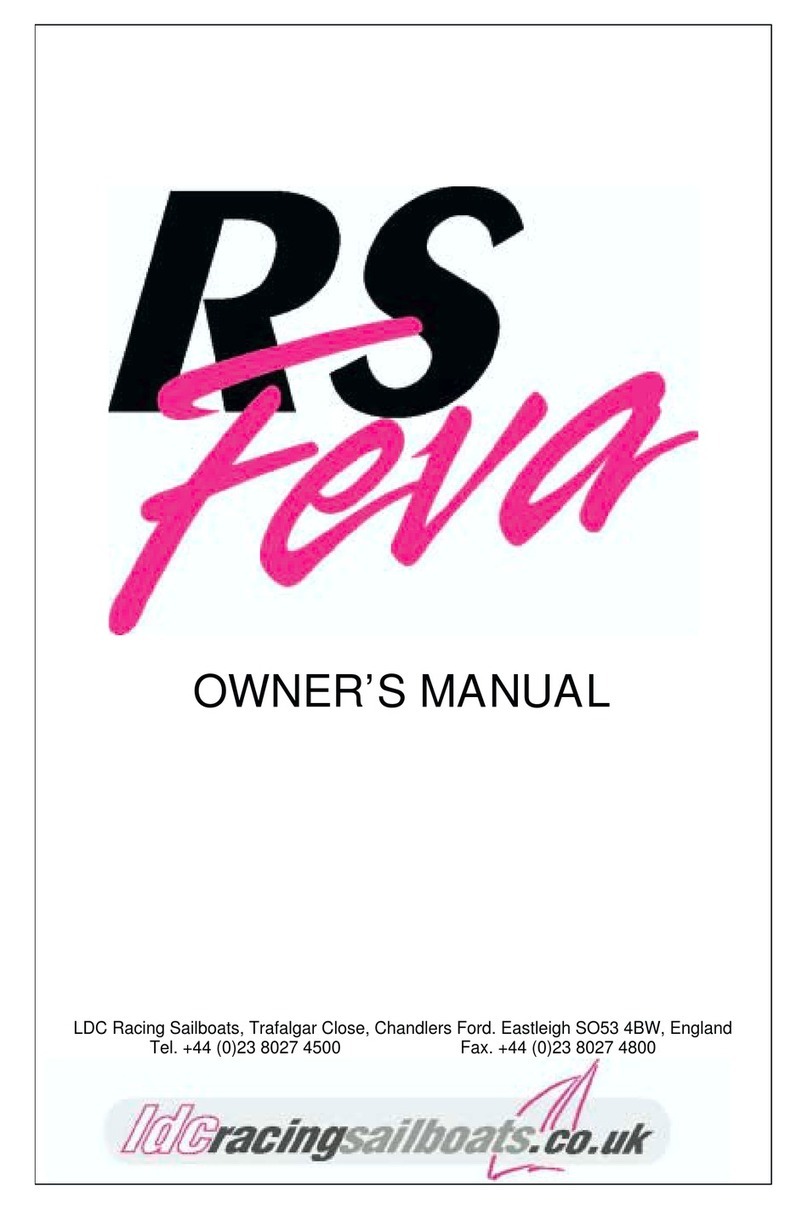Warning:
The forestay on the RS 200 is intended solely to support the mast when ashore without sails
hoisted. Do not attempt to sail the boat without a fully hoisted and tensioned jib. Should the jib fall
down or lose tension for any reason return to shore as quickly as possible sheeting the mainsail only
lightly.
Normally, before lowering the mast:-
(1) Un-reave the spinnaker halyard tail right back to the exit slot in the mast.
(2) Make a large bowline in the fall of the halyard.
(3) Pass the whole of the tail of the halyard through the loop of the bowline.
(4) Keep hold of the bitter end of the halyard tail
(5) Pull on the halyard where it exits from the mast slot, hoisting the bowline up the mast
taking a loop of the tail with it.
(6)When the halyard has got to the end of its travel the end can now be secured at the exit slot
with a couple of half hitches.
(7) Any remainder can be wrapped around the mast or used to secure the shrouds etc.
This method of securing the spinnaker halyard when de-rigging has the
advantages of keeping everything tidy when lowering or stepping the mast.
More importantly it does not require a lot of winding or coiling which helps to
keep the halyard twist and kink free when sailing.
The Sprit is fully rigged and set at the factory but you should see the sections
below, on operating and rigging the Sprit for details of operation.
Reaving the spinnaker halyard
If you have dressed the spinnaker halyard on the mast as recommended above:-
(1) Untie the hitches and pull the halyard down.
(2) Keep the bowline on the end of the halyard and hook it over a handle of the launching
trolley. This is a precaution to ensure the halyard is not inadvertently pulled up the mast, or worse
still, pulled through the top sheave.
(3) Feed the tail of the halyard directly from the exit slot forward through the outer (unsprung)
pulley at the aft end of the sprit tube.
(4) Pass it around the single block attached to the pole launch line, situated toward the front of
the tube.
(5) Pass it back through the fairlead and cleat at the inboard end of the sprit tube.
(6) Pass the rope through a floating pulley, which is connected from the port front toe strap
eye, and the middle control line pulleys. It should be tied so the pulley is fractionally below the cleat
height so the Halyard automatically cleats on the host.
(7) Lead the halyard tail, which is now the downhaul line, directly back to the turning block at
the aft end of the spinnaker sock.
(8) When you attach the spinnaker (see:- Rigging the spinnaker), this line must be fed through
the spinnaker sock to the chute mouth and passthe rope through the first ring on the downhaul patch
and then tied to the second downhaul patch on the spinnaker. A sail batten or stiff wire will help with
this on the first occasion.
(9) Remember to pull the end of the spinnaker sheet or some other rope back through the
sock when you subsequently de-rig in order to facilitate this action in future.
Hoisting the Jib
When using a brand new jib for the first time carefully unroll it in a clean area and hold it out by the
three corners:-
(1) Ensure that the eye in the luff wire at the head is correctly aligned with the attaching tape.
(2) Now whilst applying firm tension to the luff wire make a small lashing at the tack between
the eyelet in the sail and the eye in the luff wire ensuring these are correctly aligned. (You cannot do




























